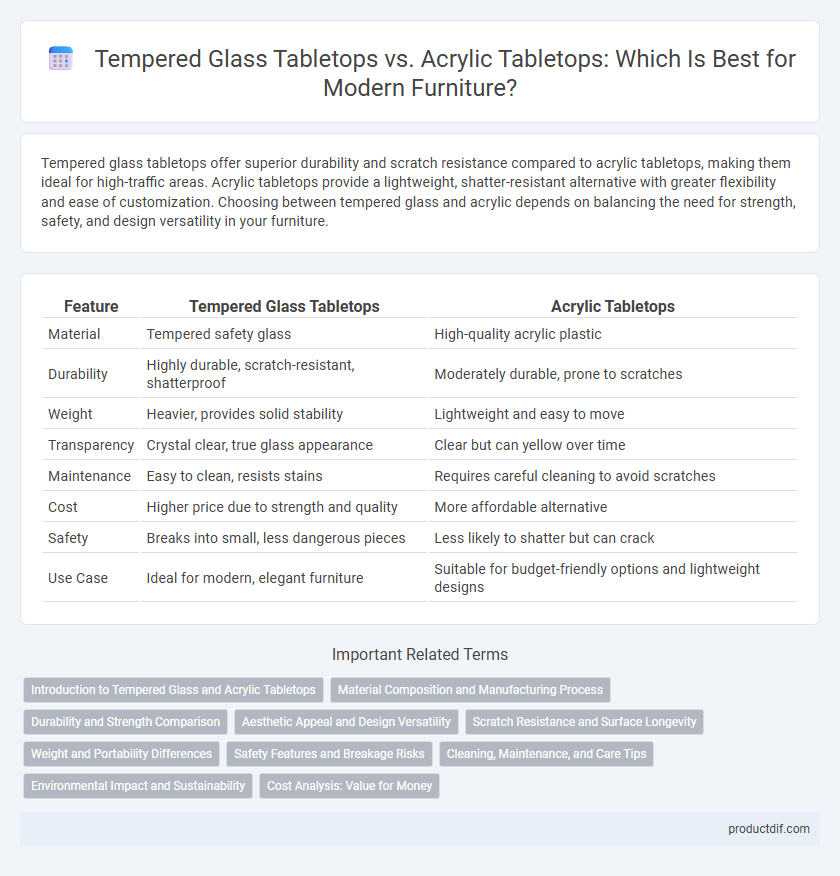Tempered glass tabletops offer superior durability and scratch resistance compared to acrylic tabletops, making them ideal for high-traffic areas. Acrylic tabletops provide a lightweight, shatter-resistant alternative with greater flexibility and ease of customization. Choosing between tempered glass and acrylic depends on balancing the need for strength, safety, and design versatility in your furniture.
Table of Comparison
| Feature | Tempered Glass Tabletops | Acrylic Tabletops |
|---|---|---|
| Material | Tempered safety glass | High-quality acrylic plastic |
| Durability | Highly durable, scratch-resistant, shatterproof | Moderately durable, prone to scratches |
| Weight | Heavier, provides solid stability | Lightweight and easy to move |
| Transparency | Crystal clear, true glass appearance | Clear but can yellow over time |
| Maintenance | Easy to clean, resists stains | Requires careful cleaning to avoid scratches |
| Cost | Higher price due to strength and quality | More affordable alternative |
| Safety | Breaks into small, less dangerous pieces | Less likely to shatter but can crack |
| Use Case | Ideal for modern, elegant furniture | Suitable for budget-friendly options and lightweight designs |
Introduction to Tempered Glass and Acrylic Tabletops
Tempered glass tabletops are made through a heat treatment process that increases strength and safety, making them resistant to impact and heat compared to regular glass. Acrylic tabletops, crafted from lightweight and shatter-resistant plastic, offer high clarity with greater flexibility and ease of customization. Both materials serve as durable, stylish surfaces, but differ in scratch resistance, weight, and maintenance requirements.
Material Composition and Manufacturing Process
Tempered glass tabletops are made from heat-treated glass that undergoes controlled thermal or chemical processes to enhance strength and resistance to impact and heat, resulting in a durable, shatter-resistant surface ideal for heavy use. Acrylic tabletops, composed of polymethyl methacrylate (PMMA), are produced through polymerization of methyl methacrylate monomers, allowing for lightweight, flexible, and impact-resistant surfaces that are easier to mold and customize. The manufacturing process of tempered glass involves heating to approximately 620degC followed by rapid cooling, while acrylic is formed through casting or extrusion methods, impacting their durability, transparency, and scratch resistance in furniture applications.
Durability and Strength Comparison
Tempered glass tabletops offer superior durability and strength due to their heat-treated composition, making them highly resistant to scratches, impacts, and thermal stress compared to acrylic tabletops. Acrylic tabletops, while lightweight and shatter-resistant, are more prone to surface scratches and can deform under prolonged pressure or heat exposure. Choosing tempered glass ensures long-lasting sturdiness and maintains clarity over time, ideal for high-traffic furniture surfaces.
Aesthetic Appeal and Design Versatility
Tempered glass tabletops offer a sleek, modern aesthetic with high transparency and reflective qualities that enhance contemporary furniture designs, providing a sophisticated and elegant look. Acrylic tabletops allow for greater design versatility due to their lightweight nature, wide range of colors, and ability to be easily molded into various shapes, making them ideal for creative and customized furniture pieces. Both materials contribute distinct aesthetic values, with tempered glass emphasizing clarity and durability, while acrylic prioritizes adaptability and vibrant visual appeal.
Scratch Resistance and Surface Longevity
Tempered glass tabletops offer superior scratch resistance due to their heat-treated surface, which significantly enhances durability compared to acrylic tabletops that are more prone to scratches and scuffs over time. The hardened surface of tempered glass maintains its clarity and smoothness longer, making it ideal for high-traffic or frequently used furniture. Acrylic tabletops, while lightweight and impact-resistant, require more careful maintenance to preserve surface integrity and prevent visible wear.
Weight and Portability Differences
Tempered glass tabletops are significantly heavier than acrylic tabletops, making them less portable and more challenging to move or rearrange. Acrylic tabletops, known for their lightweight nature, offer greater ease in transportation and flexibility in furniture arrangements without compromising durability. The weight difference directly impacts the choice of material for spaces requiring frequent mobility or quick setup changes.
Safety Features and Breakage Risks
Tempered glass tabletops offer superior safety features due to their heat-treated manufacturing process, which makes them up to five times stronger than standard glass and causes them to shatter into small, blunt pieces rather than sharp shards. Acrylic tabletops, while lighter and more impact-resistant, are prone to scratching and can crack under significant stress, posing potential safety hazards over time. Choosing tempered glass reduces breakage risks in high-traffic areas, enhancing both durability and user protection in furniture design.
Cleaning, Maintenance, and Care Tips
Tempered glass tabletops resist scratches and stains, requiring a simple wipe-down with a non-abrasive cleaner and a microfiber cloth to maintain clarity. Acrylic tabletops, while lighter and shatter-resistant, can scratch more easily and should be cleaned with mild soap and water, avoiding abrasive materials to prevent surface damage. Both materials benefit from regular dusting and the use of coasters to extend their lifespan and preserve their appearance.
Environmental Impact and Sustainability
Tempered glass tabletops offer superior durability and are 100% recyclable, reducing landfill waste and supporting circular economy initiatives. Acrylic tabletops, while lightweight and shatter-resistant, are derived from non-renewable petroleum and pose challenges in recycling due to potential chemical degradation. Choosing tempered glass over acrylic enhances environmental sustainability through better lifecycle management and lower ecological footprint.
Cost Analysis: Value for Money
Tempered glass tabletops typically cost more upfront but offer superior scratch resistance, heat tolerance, and durability, providing long-term value for high-use environments. Acrylic tabletops are more affordable and lightweight but may yellow over time and are prone to scratches, making them a cost-effective option for less intensive use. Comparing initial investment and lifespan, tempered glass provides better return on investment through enhanced durability and minimal maintenance costs.
Tempered Glass Tabletops vs Acrylic Tabletops Infographic

 productdif.com
productdif.com